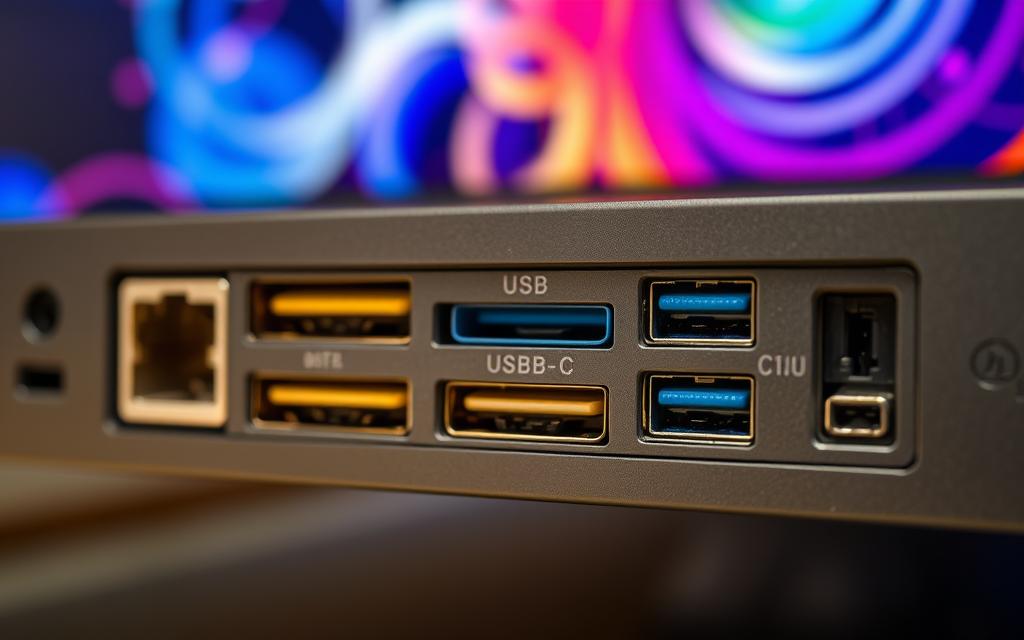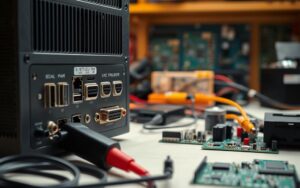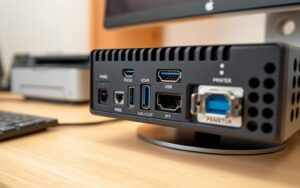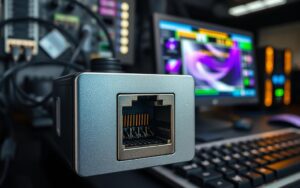Table of Contents
In today’s computing world, USB ports are key for linking various devices together. The Universal Serial Bus (USB) was created in the 1990s to make data transfer and power sharing easier between computer add-ons. Since its inception, USB technology has grown, introducing many connector styles for different needs.
Computer peripherals like mice and keyboards connect through USB ports. They also allow quick data sharing with external hard drives. Knowing about USB ports and their types is important. It enhances how we use computers by making them more versatile.
Introduction to USB Ports
USB ports are key for linking a wide range of devices to computers and other electronics. They play a huge role in enabling USB communication across different devices. Knowing about the various computer ports helps users with connectivity choices.
USB ports have evolved from version 1.1 to the latest, version 3.1, improving greatly over time. They’ve introduced numerous layouts, such as USB-A, USB-B, Micro USB, and USB Type C. Each version offers better capabilities.
When it comes to data transfer, USB ports are much faster than old serial or parallel ports. They can transfer data over 100 times quicker. This speed is vital for moving data between devices like USB sticks. USB Type C is becoming the norm, replacing other types and saving space in gadgets.
USB tech has changed the way we interact with computers, making significant strides in device networking and power supply. It allows for hot swapping, where devices can be connected or disconnected without a system reboot. This feature enhances user experience greatly. USB’s role in computing gets more critical as it evolves.
| USB Standard | Maximum Speed | Power Delivery | Common Uses |
|---|---|---|---|
| USB 1.1 | 1.5 Mbps | N/A | Basic peripherals |
| USB 2.0 | 480 Mbps | Up to 2.5 W | Keyboards, mice, printers |
| USB 3.0 | 5 Gbps | Up to 4.5 W | External hard drives, SSDs |
| USB 3.1 | 10 Gbps | Up to 100 W | High-speed data devices |
| USB4 | Up to 80 Gbps | Up to 240 W | Latest devices and compatibility |
What is USB Port in Computer?
Understanding what USB means is key for anyone using today’s tech. It’s called Universal Serial Bus and changed how devices connect. It works for data sharing and powering gadgets. This concept started in the mid-1990s. It aimed to replace many old connectors with one effective standard.
Definition and History of USB
The story of USB began in 1996. Its goal was to make connecting devices simpler. At first, USB 1.0 moved data at 1.5 Mbps. Then, USB 2.0 jumped to 480 Mbps, a huge improvement. USB 3.0 brought even faster speeds of up to 5 Gbps. Later, USB 3.1 and USB 3.2 increased this to 10 Gbps and 20 Gbps. The newest, USB 4.0, reaches speeds up to 40 Gbps. It shows modern computing relies heavily on USB.
Importance of USB Ports in Modern Computing
USB ports are crucial in today’s tech world. They make transferring data fast and simple. You can back up your files, connect important accessories like keyboards, and charge devices easily. The USB-C connector is even more versatile. It lets devices charge each other and supports high-definition screens. This connector type is easy to use and matches future tech needs. The European Union chose USB-C as the standard for all tech devices. This makes USB ports essential for connecting our technology in a closely linked world.
Types of USB Ports
Exploring different USB ports helps us understand how devices talk to each other. There are many types, like USB-A, USB-B, Micro-USB, Mini-USB, and USB-C. Each one has special features for certain tasks. Let’s dive into these USB standards and see what makes them different.
USB-A: The Original Standard
USB-A, or USB Type-A, is very common. You see its flat, rectangle shape on many computers. It’s often used to connect things like keyboards, mice, and hard drives. There are a few versions, like USB 1.1, USB 2.0, and USB 3.0 Type A. USB 3.0 is special because it transfers data super fast, up to 5 Gbps, thanks to its nine extra pins.
USB-B: Common in Larger Devices
USB-B connectors are square and mainly found on big devices like printers. They come in versions like USB 1.1, USB 2.0, and USB 3.0 Type B. The newest version, USB 3.0, works fast but won’t fit in older plugs. This ensures large devices can quickly move lots of data without issues.
Micro-USB and Mini-USB: The Smaller Connectors
Micro-USB and Mini-USB connectors fit smaller devices. Micro-USB is in some older phones and tablets. Mini-USB was popular before Micro-USB took over. Despite USB-C becoming more common, these small connectors helped make devices thinner while keeping them useful.
USB-C: The Future of Connectivity
USB-C is the latest in USB tech. Its design makes it easy to plug in without looking. It can move data quickly, charge devices, and even connect to screens. With 24 pins, it can power up devices with up to 100 watts. USB-C’s speed of up to 40 Gbps shows it’s ready to take over from the older USB types, offering advanced connections for many gadgets.
| USB Type | Shape | Common Use | Data Transfer Rate |
|---|---|---|---|
| USB Type-A | Rectangular | Computers, peripherals | Up to 5 Gbps (USB 3.0) |
| USB Type-B | Square | Larger devices (printers, scanners) | Up to 5 Gbps (USB 3.0) |
| Micro-USB | Smaller rectangular | Mobile devices (older smartphones) | Up to 480 Mbps (USB 2.0) |
| Mini-USB | Compact rectangular | Portable devices (previously common) | Up to 480 Mbps (USB 2.0) |
| USB Type-C | Symmetrical oval | All modern devices | Up to 40 Gbps (USB 4.0) |
For tips on finding and using USB ports on your computer, check out this link.
Understanding USB Data Transfer Speeds
USB ports have varying data transfer speeds that affect efficiency. Knowing about different standards and speeds helps users choose the right devices and cables. This not only boosts performance but also keeps up with USB technology advancements.
USB 1.x and 2.0: Early Standards
USB 1.0 emerged in January 1996, offering speeds of 1.5 Mbps. It helped set the stage. Then USB 1.1 came in August 1998, boosting speeds to 12 Mbps and gaining popularity. By April 2000, USB 2.0 was here with speeds up to 480 Mbps, fulfilling the need for faster data transfers and ensuring easy compatibility with older tech.
USB 3.0 and Beyond: High-Speed Transfers
In November 2008, USB 3.0 brought a big change with speeds up to 5 Gbps. It was a boon for large data files and HD video needs. USB 3.1 then doubled this to 10 Gbps in 2013, and USB 3.2 reached 20 Gbps. Look for the blue connectors and “SS” markings to identify USB 3.0.
Thunderbolt and USB 4.0: Breakthrough Speeds
USB 4.0, launched in August 2019, introduced speeds of up to 40 Gbps. It fully combines Thunderbolt tech, making it great for huge amounts of data and external displays. This standard supports data and video on one cord, streamlining the use of many devices at once.
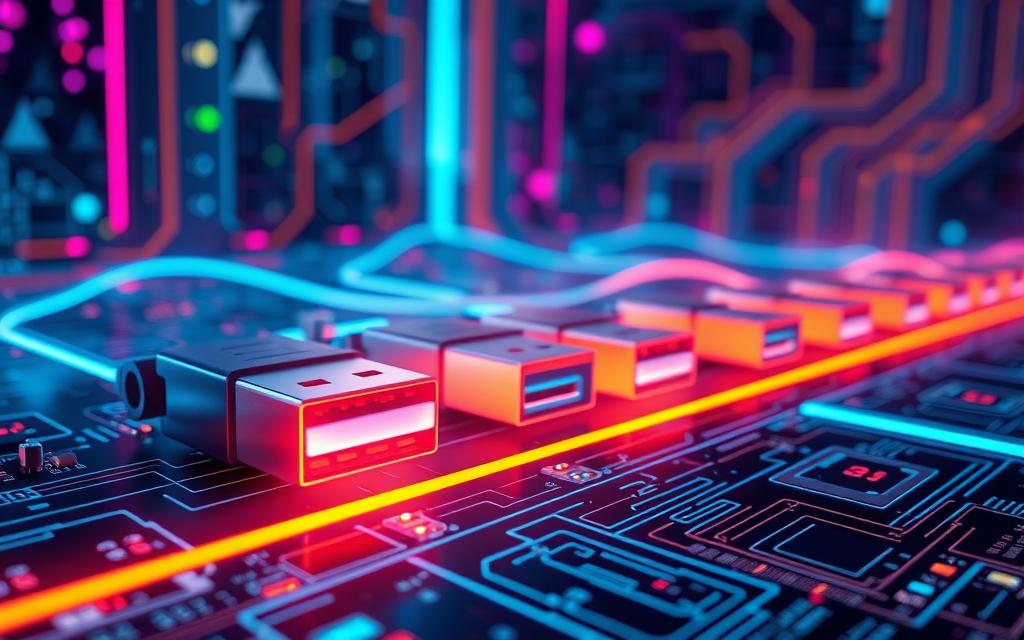
| USB Version | Release Year | Maximum Speed |
|---|---|---|
| USB 1.0 | 1996 | 1.5 Mbps |
| USB 1.1 | 1998 | 12 Mbps |
| USB 2.0 | 2000 | 480 Mbps |
| USB 3.0 | 2008 | 5 Gbps |
| USB 3.1 | 2013 | 10 Gbps |
| USB 3.2 | 2017 | 20 Gbps |
| USB 4.0 | 2019 | 40 Gbps |
For an in-depth understanding of USB speeds and finding the best connections, explore tools and compatibility checks at optimising data transfer capabilities.
Power Delivery and Charging Capabilities
In recent years, Power Delivery (PD) has made USB charging more versatile. It supports various devices with its dynamic power negotiation. This change greatly improves how devices are charged.
Understanding Power Delivery Standards
USB Power Delivery boosts the power output of USB ports significantly. It’s essential for effectively charging laptops and other power-hungry devices. Both the power source and the device can talk to each other to agree on the needed power. For example, a USB-C port can offer up to 100 watts, making it perfect for charging laptops or running displays.
Charging Power Ratings of Different USB Types
Different USB specs offer various power ratings for charging:
| USB Type | Voltage (V) | Current (A) | Power Rating (W) | Use Cases |
|---|---|---|---|---|
| USB 2.0 | 5 | 0.5 | 2.5 | Basic devices like keyboards |
| USB 3.0 / 3.1 | 5 | 0.9 | 4.5 | Tablets and smartphones |
| USB-C (non-PD) | 5 | 3 | 15 | Standard power supply for small devices |
| USB Power Delivery 1.0 | Varies | Varies | 10 – 100 | Smartphones to workstations |
| USB Power Delivery 2.0 & 3.0 | Varies | Varies | 10 – 100 | Broad range including laptops and displays |
Technologies like Qualcomm Quick Charge 5 also make quick charging possible. For example, an 18W charger can get an iPhone 12 to 50% in just 30 minutes.
Video Delivery Potential of USB Ports
USB technology has evolved, greatly boosting its video delivery skills with the USB-C ports launch. These ports do more than transfer data; they’re key for high-quality video output. This makes them crucial in today’s computing world.
How USB-C Facilitates Video Output
USB-C ports extend the regular USB capabilities. They offer smooth USB-C video transmission, connecting devices to monitors without extra cables. This means a single cable can carry power, data, and video, changing how we use technology. They even make sure 4K videos look sharp and bright.
Compatibility with Monitors and Displays
USB compatibility really stands out with USB-C. It works with many displays, including HDMI and DisplayPort. Plus, you can use adapters for older monitors. Many professionals use it to hook up several screens at once. This boosts work efficiency and creates better workspaces.
With USB4 on the horizon, we expect even faster transfer speeds and new display standards compatibility. For more about USB ports and what they do, have a look at this detailed resource.
Choosing the Right USB Cable
Finding the right USB cable is key for the best performance and safety of your devices. It’s easy to spot good USB cables because they have USB-IF certification marks. This shows they meet high safety and performance guidelines. Picking these cables ensures your devices work well together.
Identifying Certified USB Cables
To find the best cables, keep an eye on a few important things:
- Search for the official certification logos from USB Implementers Forum (USB-IF).
- Make sure the cable’s specs meet the performance standards needed.
- Pick products from well-known brands that focus on quality.
- Read reviews to see what other users think of the cables.
Choosing cables with a certification mark reduces risks of device damage. It also makes charging and data transfer better.
Risks of Using Non-Certified Cables
Some might think about going for cheaper, non-certified USB cables. These cables may cost less, but they come with many problems:
- They often don’t meet USB quality standards, leading to issues.
- They can get too hot, which is dangerous.
- They may not transfer data quickly, which is frustrating.
- Using these cables can damage your devices over time.
Choosing certified USB cables is smarter. It keeps your devices safe and makes them work better.
Conclusion
It’s vital to understand USB ports in our world that gets more connected by the day. We have seen USB ports evolve from USB 1.x to the USB-C standard. This evolution includes faster data transfer and better power delivery.
USB technology has changed how we use our devices. It makes our daily tasks easier and more efficient. This will only continue in the future. The new USB-C connectors work faster and can handle more power. This means our devices will get even better at connecting in different ways.
USB ports make things like printing and scanning straightforward, boosting our work efficiency. Knowing about USB standards helps people choose the right tech for them. As USB keeps getting woven into more applications, it will make our devices even more useful. USB’s future looks set to make our tech experience simpler and more connected.
FAQ
What is the purpose of USB ports on computers?
USB ports are vital for connecting different devices to computers. They allow for the transfer of digital data. And also provide a power supply to gadgets like keyboards and external hard drives.
What are the different types of USB connectors?
There are several USB connectors, like USB-A, USB-B, and USB-C. Each has a unique shape and serves different purposes, fitting a variety of devices.
How has USB technology evolved over the years?
USB technology has grown a lot since the 1990s. It’s become faster and more versatile. USB 3.0 and USB-C have especially improved transfer rates and power delivery.
What are USB data transfer speeds?
USB speeds started at 1.5 Mbps with USB 1.x. Now, USB 4.0 can reach speeds up to 40 Gbps. This makes sharing large files and HD video faster.
Can USB ports charge devices?
Yes, USB ports can charge devices. USB Power Delivery even allows for faster charging. This is great for gadgets like laptops and monitors.
What is the significance of USB-C?
USB-C is the newest USB type. It’s reversible and supports fast data transfer and power delivery. It’s ideal for modern devices and setting up multiple displays.
How can I identify certified USB cables?
Look for the USB-IF certification mark on USB cables. This shows they meet safety and performance standards. It ensures they are compatible and safe to use.
What are the risks of using non-certified USB cables?
Non-certified USB cables can harm your devices. They might transfer data slowly or charge poorly. This is because they don’t meet certain quality and safety standards.
What does the term ‘Power Delivery’ mean in USB technology?
Power Delivery (PD) lets USB adjust power output for the device’s needs. This means devices can charge faster and use power more efficiently.
Can USB ports support video output?
Yes, especially USB-C ports. They can send video signals along with data and power. This is handy for connecting to monitors and displays in work and home spaces.


